EXPLANATORY
NOTE
This
revised volume is the completion between the first volume
and the report of a reconfirmation survey on marine fishing
gear and methods, conducted in August 2002. We tried
to cover the present fishing gears as much as possible
and to include all the latest developed gears, important
port and villages along the coast of Thailand. Figure
1 shows the map of all the survey station 3, the name of
each province, which is often also the name of the provincial
capital, is underlined.
The
data were collected mostly by interviewing fishermen, with
the help of questionnaire prepared in advance for each type
of fishing gear, as well as by direct observation in the
locations where the gears were made and used. The background
information on the current status of different fisheries
was mainly base on data contained in the annual “Fishery
Statistical Bulletin for the South China Sea Area”,
starting from 1990, up to the most recent available one for
1997.
In
the classification of fishing gear, drawings and explanations
in this volume, we have on the whole followed the system
used in the “FAO Catalogue of Small-Scale Fishing Gear”. The
mode of presentation is summarized below.
Illustrations
1. The
horizontal length of surrounding nets, purse seines and
gill nets is drawn according to the length of the floatline,
and the vertical depth according to the fully stretched
netting. In
the case of gill nets with sidelines, the depth is
drawn according to their length. The width of
netting panels or sections of trawl gear is drawn according
to half the stretched netting, and the depth or length
according partly perspective overall sketches, with
dimensions indicated where applicable.
2. General
outline drawings, such as of the rig of a complete gear,
and detail drawings of components, are mostly not to scale,
but the main dimensions are given.
3. Dimensions
are given only in meters (m) and millimeters (mm). The
units are not indicated but can easily be recognized, as
follows:
Metre
: Length
of footropes, headlings, floatlines etc.,
used
with two decimals (e.g., 5.25, 90.20).
Mellimetre: Mesh
size (stretched), diameters of ropes
floats,
etc.used without a point or with one
decimal
only (e.g., 12; 527 or 1.2; 20.5).
4. Mass
and weight are indicated in the units of kilogram (kg) and
gram (g). Buoyancies
of floats and breaking load of netting yarns or ropes
are shown by kilogram-force (kgf) or gram-force (gf).
5. Materials
are indicated by abbreviations listed in Appendix 1.
6. The
size of netting yarns is shown in the denier system.
7. The
mesh size, given in millimeters (mm) is understood to be
the distance between the centers of the two opposite knots
in the same mesh when fully stretched..
8. The
number of meshes in a straight row along the edges indicates
the width and length or depth of net panels or sections.
9. The
shape of a netting section is indicated by the cutting
rate at its edge. A tabulation
of common cutting rates for a practical range of taper
ratios is given in Appendix 2, together with a diagram
of different cutting rates.
10. The
term hanging ratio (E) designates the ratio between the
length of a given portion of the mounting rope and the
length of the stretched netting hung on this portion of
the rope.
11. When
there are two or more variants in construction of gear
or manner of use, this is indicated in the title and opposite
the drawings by Roman numerals (I, II, ……..
). Where
these variants refer to only one component part of gear,
other possible ways of making this part are shown with
the abbreviation ALT.
12. Sequence
in fishing operation is shown by sketches with circled
Arabic numberals ( 1, 2‚… )
which indicate the sequence of operation stages.
13.
Parts of gear drawn in detail are indicated by circled capital
letters ( A , B … )
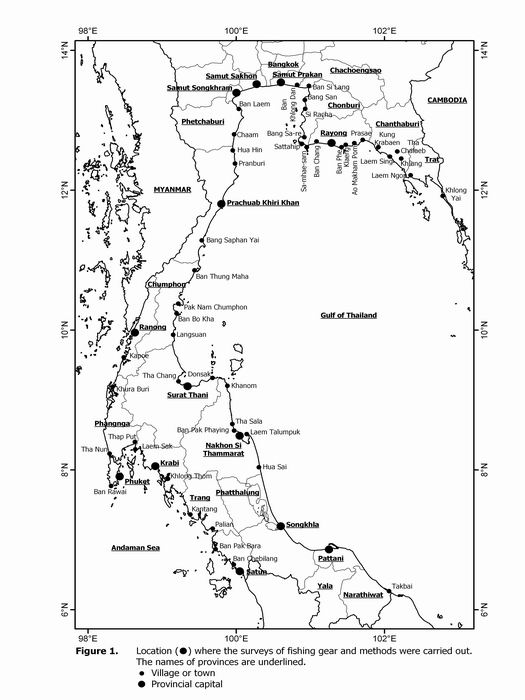 . .
Abbreviations and symbols used in illustrations
ALT
BAIT
BAM
BR
CEM
CLAY
COMB
COT
EG
Fe
LL
LIVE
LT
MAT
MONO
PA







|
=
=
=
=
=
=
=
= |
Alternative
Bait
Bamboo
Brass
Cement
Baked clay
Combination rope
Cotton
Electric generator
Iron
Luring lamp
Live bait
Long-tail boat1
Material
Monofilament
Polyamide
Diameter
Upper panel
Lower panel
Side panel
Purse ring
Thickness
Approximately |
Pb
PE
PES
PL
PP
PVA
RA
RUB
S
SN
SST
ST
SW
WD
WIRE
Z






Rv. 2002 |
=
=
=
=
=
=
=
= |
Lead
Polyethylene
Polyester
Plastic
Polypropylene
Polyvinyl alcohol
Rattan
Rubber
S twist
Saran nylon
Stainless steel
Steel
Swivel
Wood
Steel wire rope
Z twist
Circumference
Braided
Twisted
Current
Wind
Fish
Survey in 2002 |
1 Boat with a long propeller shaft outside the hull
(Source : FAO catalogue of Small-scale Fishing Gear, 1975)
Common cutting rates and
taper ratios
Number of meshes lost (or gained)
N
u
m
b
e
r
o
f
m
e
s
h
e
s
i
n
d
e
p
t
h
|
|
1 |
2 |
3 |
4 |
5 |
6 |
7 |
8 |
9 |
10 |
1 |
AB |
1T2B |
1T1B |
3T2B |
2T1B |
5T2B |
3T1B |
7T2B |
4T1B |
9T2B |
2 |
1N2B |
AB |
1T4B |
1T2B |
3T4B |
1T1B |
5T4B |
3T2B |
7T4B |
2T1B |
3 |
1N1B |
1N4B |
AB |
1T6B |
1T3B |
1T2B |
2T3B |
6T6B |
1T1B |
7T6B |
4 |
3N2B |
1N2B |
1N6B |
AB |
1T8B |
1T4B |
3T8B |
1T2B |
5T8B |
3T4B |
5 |
2N1B |
3N4B |
1N3B |
1N8B |
AB |
1T10B |
1T5B |
3T10B |
2T5B |
1T2B |
6 |
5N2B |
1N1B |
1N2B |
1N4B |
1N10B |
AB |
1B12B |
1T6B |
1T4B |
1T3B |
7 |
3N1B |
5N4B |
2N3B |
3N8B |
1N5B |
1N12B |
AB |
1T14B |
1T7B |
3T14B |
8 |
7N2B |
3N2B |
5N6B |
1N2B |
3N10B |
1N6B |
1N14B |
AB |
1T16B |
1T8B |
9 |
4N1B |
7N4B |
1N1B |
5N8B |
2N5B |
1N4B |
1N7B |
1N16B |
AB |
1T18B |
10 |
9N2B |
2N1B |
7N6B |
3N4B |
1N2B |
1N3B |
3N14B |
1N8B |
1N18B |
AB |
11 |
5N1B |
9N4B |
4N3B |
7N8B |
3N5B |
5N12B |
2N7B |
3N16B |
1N9B |
1N20B |
12 |
11N2B |
2N2B |
3N2B |
1N1B |
7N10B |
1N2B |
5N14B |
1N4B |
1N6B |
1N10B |
13 |
6N1B |
11N4B |
5N3B |
9N8B |
4N5B |
7N12B |
13N7B |
5N16B |
2N9B |
3N20B |
14 |
13N2B |
3N1B |
11N6B |
5N4B |
9N10B |
2N3B |
1N2B |
3N8B |
5N18B |
1N5B |
15 |
7N1B |
13N4B |
2N1B |
11N8B |
1N1B |
3N4B |
4N7B |
7N16B |
1N3B |
1N4B |
16 |
5N2B |
7N2B |
13N6B |
3N2B |
11N10B |
5N6B |
9N14B |
1N2B |
7N18B |
3N10B |
17 |
8N1B |
15N4B |
7N3B |
13N8B |
6N5B |
11N12B |
5N7B |
9N16B |
4N9B |
7N10B |
18 |
17N2B |
4N1B |
5N2B |
7N4B |
13N10B |
1N1B |
11N14B |
5N8B |
1N2B |
2N5B |
19 |
9N1B |
17N4B |
8N3B |
15N8B |
7N5B |
13N12B |
6N7B |
11N16B |
5N9B |
9N20B |
(Source: FAO catalogue of Small-scale Fishing
Gear, 1975)
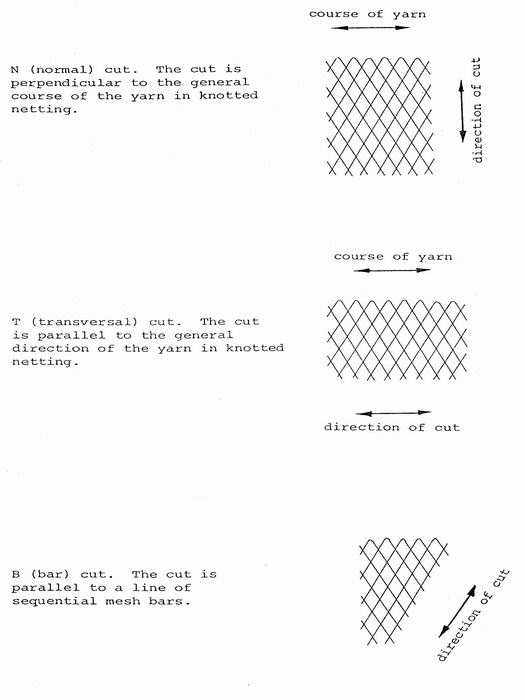
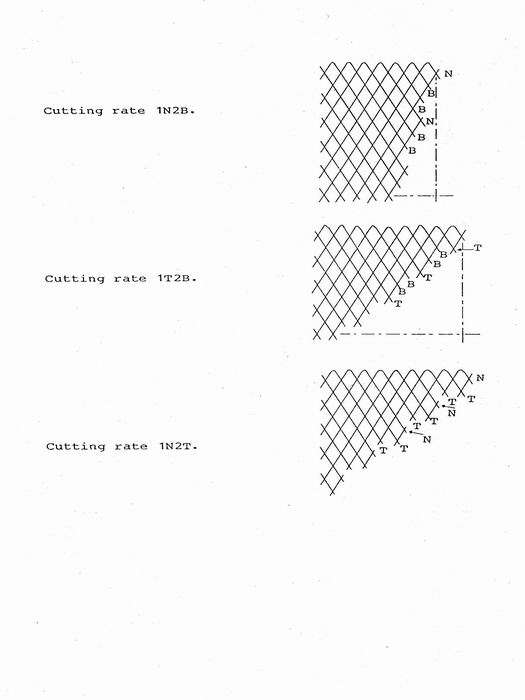
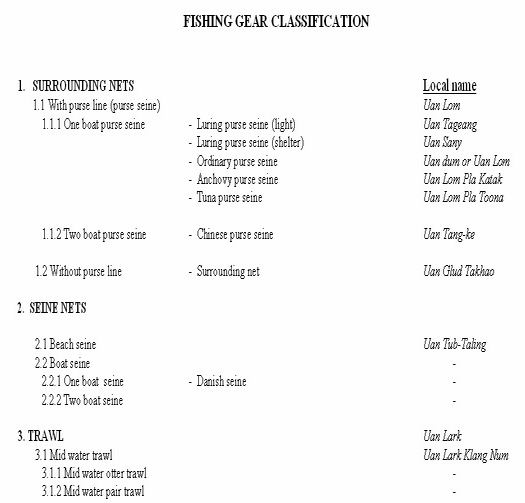
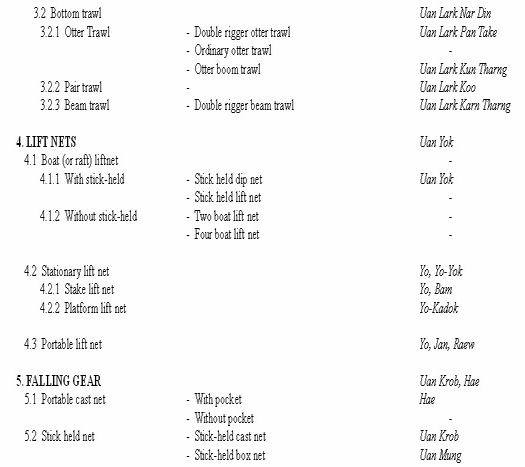
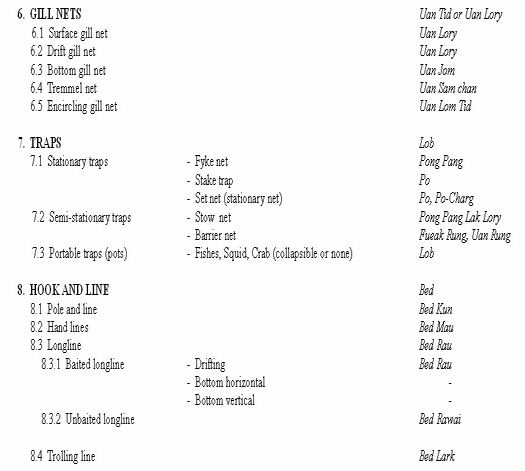
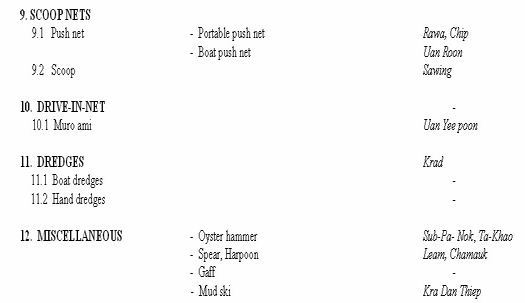
Groups of fishing gear and
descriptions
1. SURROUNDING NET
A
net roughly rectangular in shape without a distinct bag is
set vertically in water; to surround the school of fish,
generally of pelagic nature. The nets are subdivided
into three major types: One boat purse seine; two boat purse
seine; and Surrounding net without a purse line.
2. SEINE NET
A
bag shaped net with two wings, normally, the wing are larger than those of
trawl nets. The net is pulled towards a stationary boat or onto a beach. A
seine of a primitive nature sometimes does not have a bag. However,
insofar as the net is pulled towards a stationary boat or beach, it is included
herein.
3. TRAWL
A
conical bag shaped-net with two or more wings, pulled by one to two boats for
a period of time, to catch mainly fish or other aquatic animals that live directly
on, or stay near the sea bed. When such a gear is used in mid-water,
with the same catching mechanism, the mid-water trawl is included herein.
The
trawl is also divided into three major types: Otter trawl; Pair trawl; and
Beam trawl.
4. LIFT NET
A
sheet of net, usually square, but may sometimes be conical, is stretched either
by several rods, ropes, or a frame and is set either at the bottom or in mid-water
for some time; and then lifted to trap the fish lying above it.
5. FALLING GEAR
The
gear is usually a cone shaped net or other material, which is dropped to cover
aquatic animals and enclose them. Generally hand-operated in shallow
waters, but some are operated from a boat for example, the stick-held cast
net.
6. GILL NET
A
net wall, with its lower end weighted by sinkers (or heavy net, as in drift
gill net) and the upper end raised by floats, is set transversely to the path
of migrating fish. Fish trying to make their way through the net wall
are entangled in the mesh. A catching mechanism which is more or less
similar to the gill net, is the trammel net with three wall nets, this is also
included herein. Although in this case the migrating fish are entangled
between two layers of net, and not in the mesh, and a combination of different
types of nets are used.
7. TRAP
Gear
that is set or stationed in the water for a certain period, regardless of the
kind of material used for their construction. The fish are naturally confined
in a collecting unit, from which escape is prevented by labyrinths and/or retarding
devices, such as gorges, funnels, etc. without any active fishing operation
taking place.
8. HOOK AND LINE
This
gear generally consists of line(s) and hook(s), to which edible or artificial
baits are attached to attract fish or other aquatic animals. Unbaited
hooks or jig may also be used.
9. SCOOP NET
A
bag net with a fixed or variable opening is operated in shallow waters, or
from boats. Some large scale scoop nets are operated from a motorized
boat, such as the boat push net.
10. DRIVE-IN-NET
A
bag net with two wings, scoop net and wall with a coconut leaf fence are usually
set in the water against the current. From one to two hundred fishermen
with their frightening ropes and plastic hoses which emit bubbles, drive the
fish to enter the bag net and/or scoop net. A lift net is used to catch
fish which are circling the net wall.
11. DREDGE
An
iron or net basket with a hard rectangular frame at the opening. This
gear is dragged or pushed along the sea bed, usually to collect mollusks such
as mussels, oysters, scallops, clams, etc. The shellfish are held in
an attached bag or sieve which allows the water, sand or mud to run out.
12. MISCELLANEOUS
This
group covers a great variety of other fishing gears and methods, not specified
elsewhere or that are based on mixed principles. For example hand hooks,
harpoons or spears, gaff, etc. |